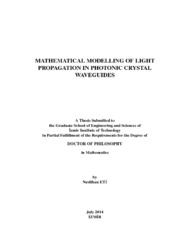Please use this identifier to cite or link to this item:
https://hdl.handle.net/11147/4174Full metadata record
| DC Field | Value | Language |
|---|---|---|
| dc.contributor.advisor | Sözüer, Hüseyin Sami | - |
| dc.contributor.author | Eti, Neslihan | - |
| dc.date.accessioned | 2014-11-17T14:17:27Z | - |
| dc.date.available | 2014-11-17T14:17:27Z | - |
| dc.date.issued | 2014 | - |
| dc.identifier.uri | http://hdl.handle.net/11147/4174 | - |
| dc.description | Thesis (Doctoral)--Izmir Institute of Technology, Mathematics, Izmir, 2014 | en_US |
| dc.description | Includes bibliographical references (leaves: 100-103) | en_US |
| dc.description | Text in English; Abstract: Turkish and English | en_US |
| dc.description | xiii, 103 leaves | en_US |
| dc.description.abstract | Photonic crystals are artificially engineered materials where the dielectric constant varies periodically. A photonic band gap can be created by scattering at the dielectric interfaces, which forbids propagation of light in a certain frequency range of light. This property enables us to control light, which is normally impossible with conventional optics. Moreover, by placing a linear defect into the photonic crystal, one can construct a waveguide, which keeps light inside the waveguide in the desired direction. Thus, by using photonic crystal waveguides one can control light propagation in integrated circuit devices. The goal of this work is to provide a comprehensive understanding of how to bend light using photonic crystal waveguides. The purpose is to create a 90◦ bend for line defect photonic crystal assisted waveguides and present fully three-dimensional calculations with optimized geometrical parameters that minimize the bending loss. The scheme uses one-dimensional photonic crystal slab waveguides for straight sections, and a corner element that employs a square photonic crystal with a band gap at the operating frequency.. The two different structures, with either silicon-silica or with silicon-air are used in the guiding photonic crystal layer. Furthermore, the guiding layer is sandwiched between either air on both top and bottom, or between air on top and silica substrate at the bottom, to serve as the ”cladding” medium. Calculations are presented for the transmission values of TE-like modes where the electric field is strongly transverse to the direction of propagation, with and without the photonic crystal corner element for comparison. We find that the bending loss can be reduced to under 2%. | en_US |
| dc.language.iso | en | en_US |
| dc.publisher | Izmir Institute of Technology | en_US |
| dc.rights | info:eu-repo/semantics/openAccess | en_US |
| dc.subject | Photonic crystals | en_US |
| dc.subject | Waveguide | en_US |
| dc.title | Mathematical Modelling of Light Propagation in Pohotonic Crystal Waveguides | en_US |
| dc.title.alternative | Işığın Fotonik Kristal Dalga Kılavuzunda Yayılımının Matematiksel Modellemesi | en_US |
| dc.type | Doctoral Thesis | en_US |
| dc.department | Thesis (Doctoral)--İzmir Institute of Technology, Mathematics | en_US |
| dc.relation.publicationcategory | Tez | en_US |
| dc.identifier.wosquality | N/A | - |
| dc.identifier.scopusquality | N/A | - |
| item.openairecristype | http://purl.org/coar/resource_type/c_18cf | - |
| item.languageiso639-1 | en | - |
| item.openairetype | Doctoral Thesis | - |
| item.grantfulltext | open | - |
| item.fulltext | With Fulltext | - |
| item.cerifentitytype | Publications | - |
| Appears in Collections: | Phd Degree / Doktora | |
Files in This Item:
| File | Description | Size | Format | |
|---|---|---|---|---|
| 10020643.pdf | DoctoralThesis | 3.44 MB | Adobe PDF |  View/Open |
CORE Recommender
Page view(s)
270
checked on Mar 31, 2025
Download(s)
148
checked on Mar 31, 2025
Google ScholarTM
Check
Items in GCRIS Repository are protected by copyright, with all rights reserved, unless otherwise indicated.